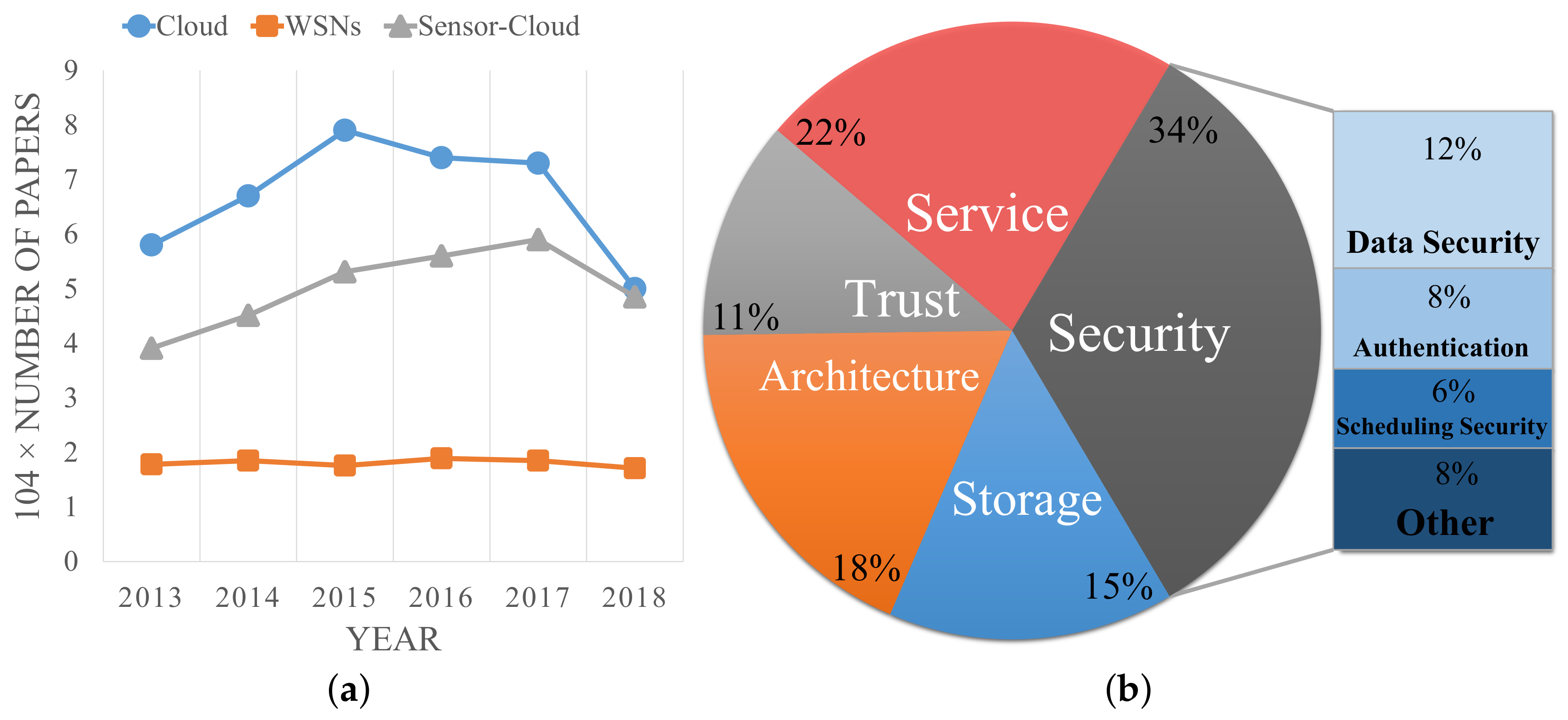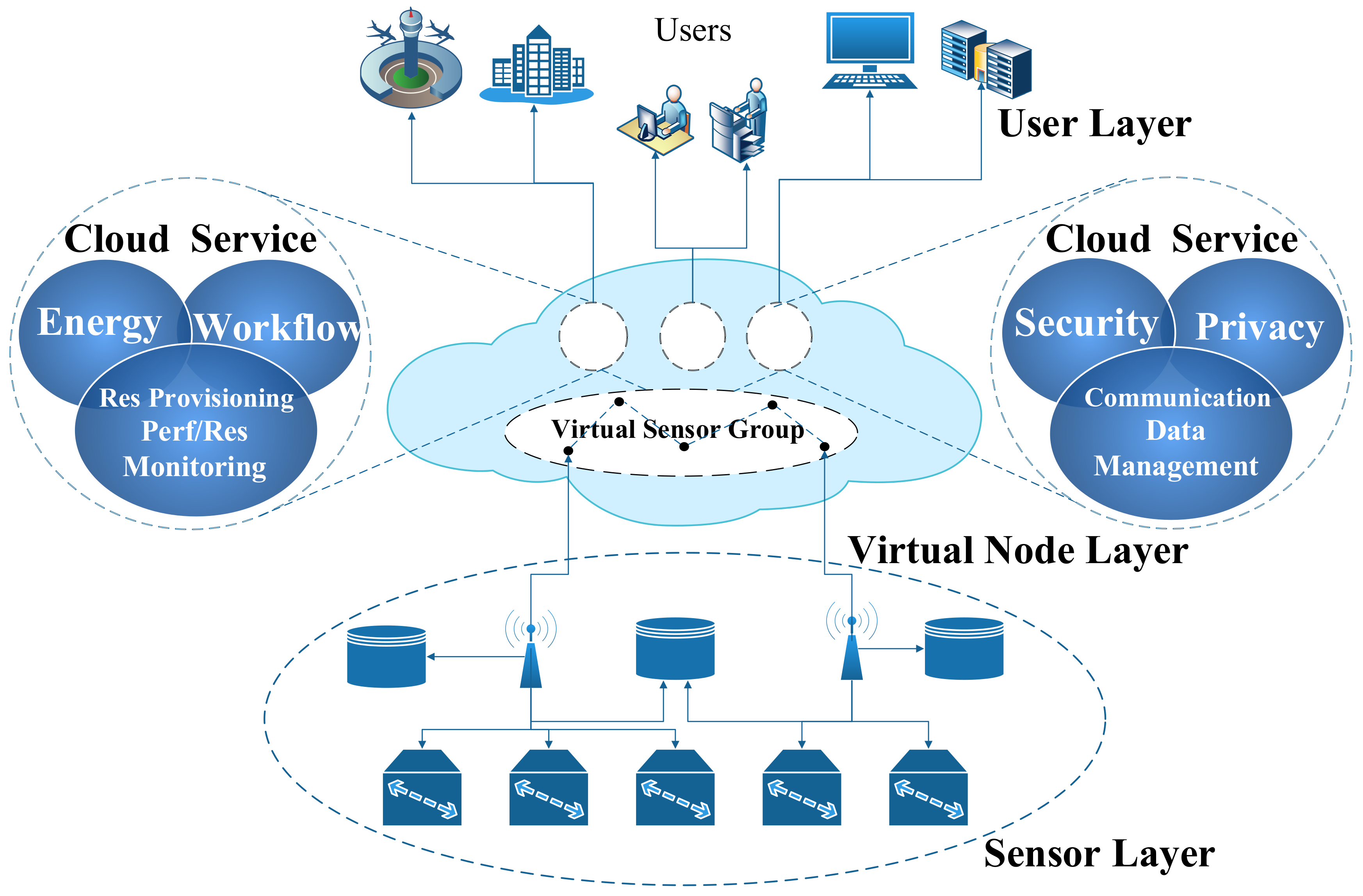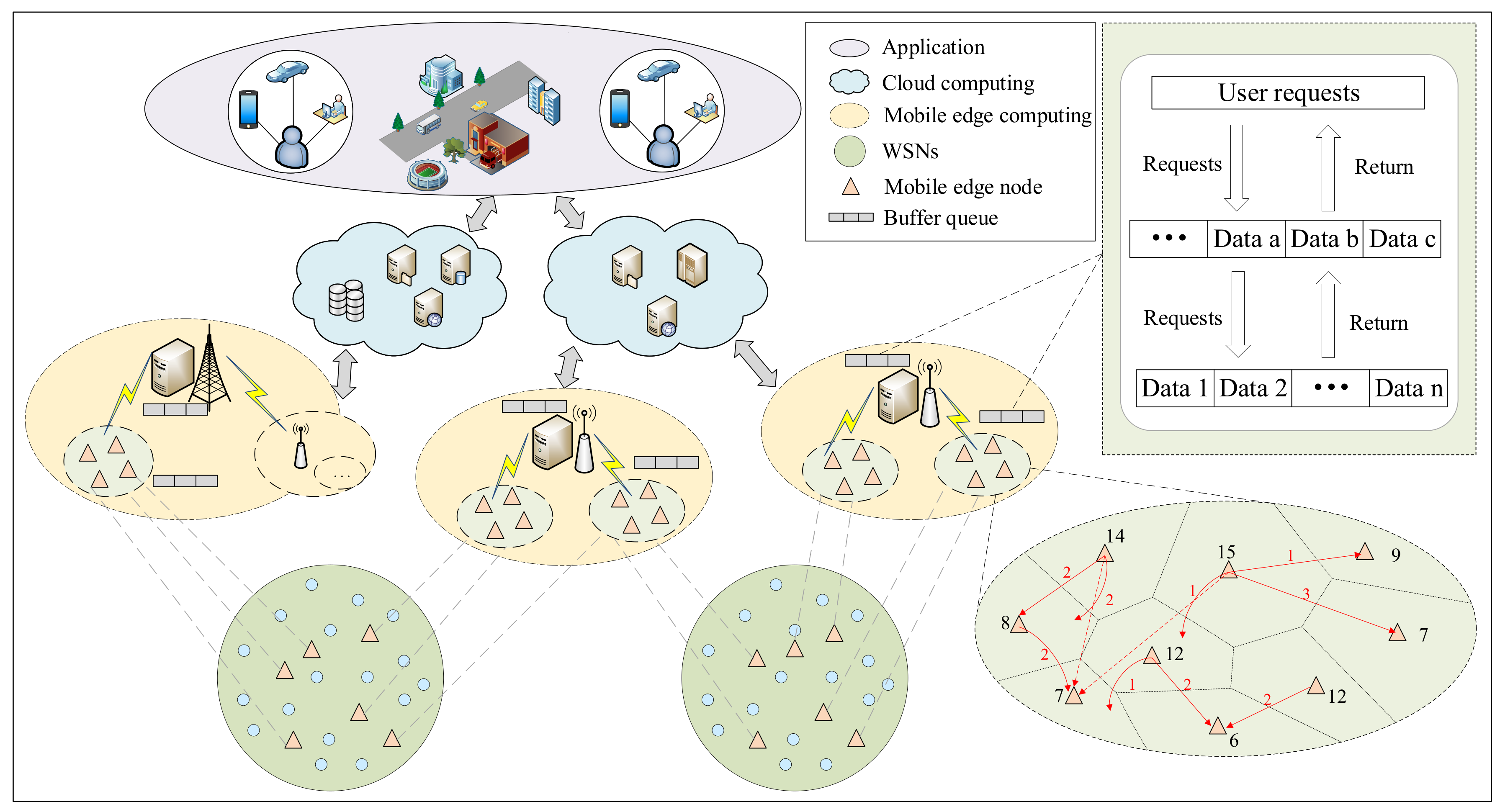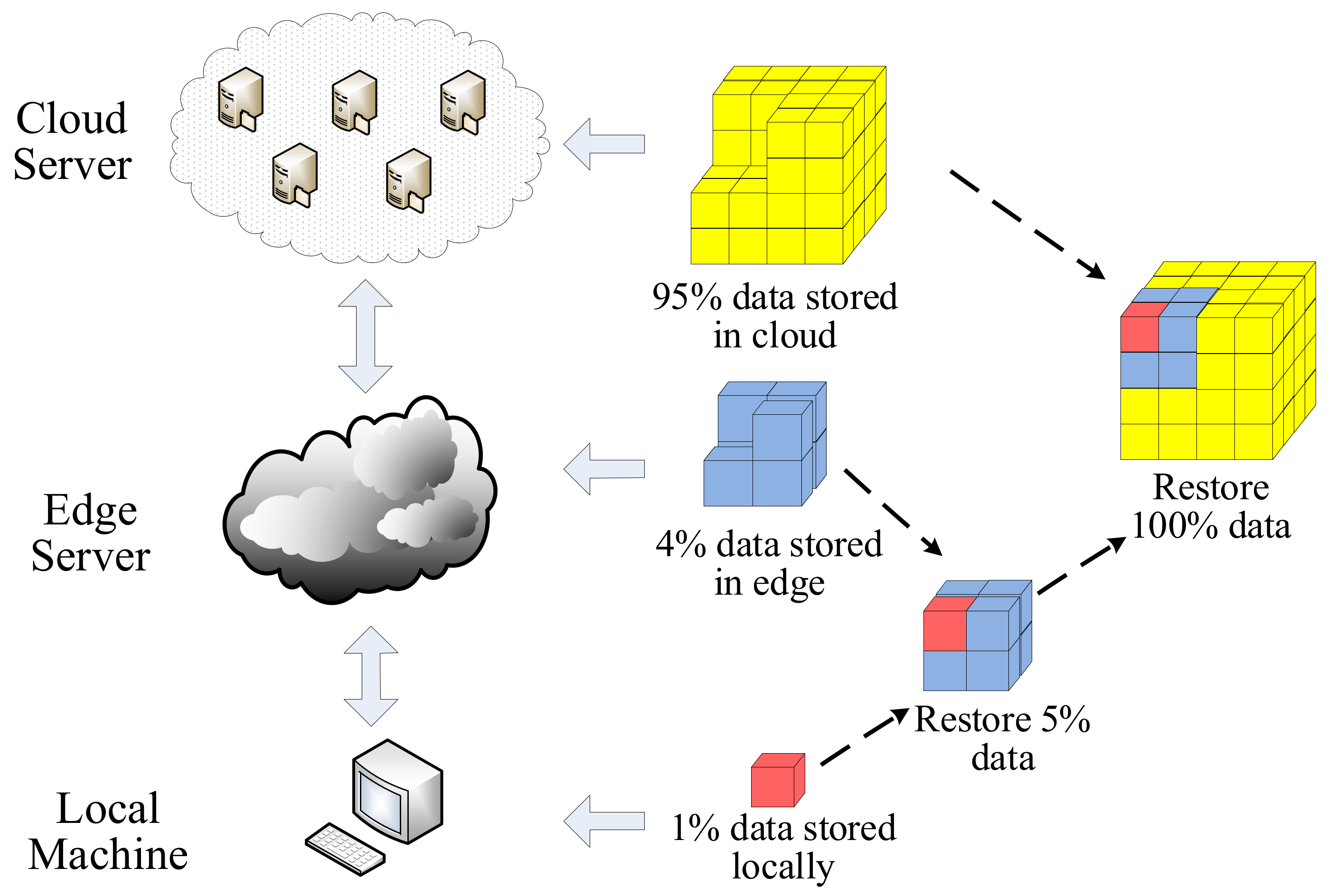When Sensor-Cloud Meets Mobile Edge Computing
Abstract
:1. Introduction
- The characteristics of sensor-clouds are summarized, and the issues in sensor-clouds are detailed. Compared with other surveys of sensor-clouds, we present the latest research status of sensor clouds based on mobile edge computing.
- We then discuss the edge-related solutions, which aim to address the data management issues (collection, trust, storage etc.) in sensor-clouds.
- The future directions and challenges are highlighted, which justify the need for in-depth research on the mobile edge-based sensor-cloud.
2. Sensor-Cloud Overview
2.1. Sensor-Cloud Design and Characteristics
2.2. Existing Implementation
3. Mobile Edge-Based Sensor-Cloud
3.1. Why Mobile Edge Computing?
3.2. Challenges and Solutions
4. State of the Art of Mobile Edge-Based Sensor-Clouds
4.1. Improvement of Sensor-Cloud Security
4.1.1. Data Collection Scheme
4.1.2. Trust Evaluation Model
4.1.3. Coupling Security
4.1.4. Storage Security
4.2. Improvement of Sensor-Cloud QoS
4.2.1. Dynamic Edge Service
4.2.2. Minimization of Cost and Maximization of Profit
5. Open Research Issues
5.1. Mobile Edge Computing for Trust Evaluation
5.2. Mobile Edge Computing for Trustworthy Data Collection
5.3. Mobile Edge Computing for Data Cleaning
6. Conclusions
Author Contributions
Funding
Conflicts of Interest
References
- Li, Q.; Liu, A.; Wang, T.; Xie, M.; Xiong, N.N. Pipeline slot based fast rerouting scheme for delay optimization in duty cycle based M2M communications. Peer Peer Netw. Appl. 2019, 12, 1673–1704. [Google Scholar] [CrossRef]
- Xie, K.; Wang, L.; Wang, X.; Xie, G.; Wen, J. Low cost and high accuracy data gathering in WSNs with matrix completion. IEEE Trans. Mob. Comput. 2018, 17, 1595–1608. [Google Scholar] [CrossRef]
- Alamri, A.; Ansari, W.S.; Hassan, M.M.; Hossain, M.S.; Alelaiwi, A.; Hossain, M.A. A survey on sensor-cloud: Architecture, applications, and approaches. Int. J. Distrib. Sens. Netw. 2013, 9, 917–923. [Google Scholar] [CrossRef]
- Zhu, C.; Leung, V.C.M.; Rodrigues, J.J.P.C.; Shu, L.; Wang, L.; Zhou, H. Social Sensor Cloud: Framework, Greenness, Issues, and Outlook. IEEE Netw. 2018, 35, 100–105. [Google Scholar] [CrossRef]
- Sukanya, C.; Priya, K.; Paul, V.; Sankaranarayanan, P. Integration of Wireless Sensor Networks and Mobile Cloud-a Survey. Int. J. Comput. Sci. Inf. Technol. 2015, 6, 159–163. [Google Scholar]
- Liu, X.; Zhao, M.; Liu, A.; Wong, K.K.L. Adjusting forwarder nodes and duty cycle using packet aggregation routing for body sensor networks. Inf. Fusion 2020, 53, 183–195. [Google Scholar] [CrossRef]
- Misra, S.; Chatterjee, S.; Obaidat, M.S. On Theoretical Modeling of Sensor Cloud: A Paradigm Shift From Wireless Sensor Network. IEEE Syst. J. 2017, 11, 1084–1093. [Google Scholar] [CrossRef]
- Ali, I.; Gani, A.; Ahmedy, I.; Yaqoob, I.; Khan, S.; Anisi, M.H. Data Collection in Smart Communities using Sensor Cloud: Recent Advances, Taxonomy, and Future Research Directions. IEEE Commun. Mag. 2018, 56, 192–197. [Google Scholar] [CrossRef] [Green Version]
- Wang, T.; Yang, L.; Fang, W.; Xu, W.; Liang, J.; Chen, Y.; Liu, X. A Comprehensive Trustworthy Data Collection Approach in Sensor-Cloud System. IEEE Trans. Big Data 2018. [Google Scholar] [CrossRef]
- Liu, J.; Yu, J.; Shen, S. Energy-efficient two-layer cooperative defense scheme to secure Sensor-Clouds. IEEE Trans. Inf. Forensics Secur. 2017, 13, 408–420. [Google Scholar] [CrossRef]
- Zhu, C.; Leung, V.C.M.; Wang, K.; Yang, L.T.; Yan, Z. Multi-Method Data Delivery for Green Sensor-Cloud. IEEE Commun. Mag. 2017, 55, 176–182. [Google Scholar] [CrossRef]
- Zhu, C.; Lei, S.; Leung, V.C.M.; Song, G.; Yang, L.T. Secure Multimedia Big Data in Trust-Assisted Sensor-Cloud for Smart City. IEEE Commun. Mag. 2017, 55, 24–30. [Google Scholar] [CrossRef]
- Wang, T.; Peng, Z.; Wen, S.; Wang, G.; Wang, B.; Liu, A. A Survey of Fog Computing in Wireless Sensor Networks: Concepts, Frameworks, Applications and Issues. Ad Hoc Sens.Wirel. Netw. 2019, 44, 109–130. [Google Scholar]
- Ojha, T.; Misra, S.; Raghuwanshi, N.S.; Poddar, H. DVSP: Dynamic Virtual Sensor Provisioning in Sensor-Cloud based Internet of Things. IEEE Internet Things J. 2019, 6, 5265–5272. [Google Scholar] [CrossRef]
- Qi, L.; Dou, W.; Chen, J. Weighted principal component analysis-based service selection method for multimedia services in cloud. Computing 2016, 98, 195–214. [Google Scholar] [CrossRef]
- Liu, X.; Liu, A.; Wang, T.; Ota, K.; Dong, M.; Liu, Y.; Cai, Z. Adaptive data and verified message disjoint security routing for gathering big data in energy harvesting networks. J. Parallel Distrib. Comput. 2020, 135, 140–155. [Google Scholar] [CrossRef]
- Wang, Y.; Ding, Y.; Wu, Q.; Wei, Y.; Qin, B.; Wang, H. Privacy-preserving cloud-based road condition monitoring with source authentication in vanets. IEEE Trans. Inf. Forensics Secur. 2018, 14, 1779–1790. [Google Scholar] [CrossRef]
- Zeng, X.; Wang, W.; Chen, C.; Yen, G.G. A Consensus Community-Based Particle Swarm Optimization for Dynamic Community Detection. IEEE Trans. Cybern. 2019. [Google Scholar] [CrossRef]
- Kuang, Z.; Liu, G.; Li, G.; Deng, X. Energy efficient resource allocation algorithm in energy harvesting-based D2D heterogeneous networks. IEEE Internet Things J. 2019, 6, 557–567. [Google Scholar] [CrossRef]
- Misra, S.; Singh, A.; Chatterjee, S.; Mandal, A.K. QoS-aware sensor allocation for target tracking in sensor-cloud. Ad Hoc Netw. 2015, 33, 140–153. [Google Scholar] [CrossRef]
- Xu, P.; He, S.; Wang, W.; Susilo, W.; Jin, H. Lightweight searchable public-key encryption for cloud-assisted wireless sensor networks. IEEE Trans. Ind. Inform. 2017, 14, 3712–3723. [Google Scholar] [CrossRef]
- Xu, H.; Zeng, W.; Zhang, D.; Zeng, X. MOEA/HD: A multiobjective evolutionary algorithm based on hierarchical decomposition. IEEE Trans. Cybern. 2017, 49, 517–526. [Google Scholar] [CrossRef] [PubMed]
- Xu, H.; Zeng, W.; Zeng, X.; Yen, G.G. An evolutionary algorithm based on Minkowski distance for many-objective optimization. IEEE Trans. Cybern. 2019, 49, 3968–3979. [Google Scholar] [CrossRef] [PubMed]
- Li, D.; Li, M.; Liu, J. A dynamic multiple-keys game-based industrial wireless sensor-cloud uthentication scheme. J. Supercomput. 2018, 74, 6794–6814. [Google Scholar] [CrossRef]
- Wang, T.; Mei, Y.; Jia, W.; Zheng, X.; Wang, G.; Xie, M. Edge-based differenital privacy computing for sensor-cloud systems. J. Parallel Distrib. Comput. 2019. [Google Scholar] [CrossRef]
- Hu, L.; Liu, A.; Xie, M.; Wang, T. UAVs joint vehicles as data mules for fast codes dissemination for edge networking in smart city. Peer Peer Netw. Appl. 2019, 12, 1550–1574. [Google Scholar] [CrossRef]
- Tang, Q.; Xie, M.; Yang, K.; Luo, Y.; Zhou, D.; Song, Y. A decision function based smart charging and discharging strategy for electric vehicle in smart grid. Mob. Netw. Appl. 2019, 24, 1722–1731. [Google Scholar] [CrossRef]
- Soleymani, S.A.; Abdullah, A.H.; Zareei, M.; Anisi, M.H.; Vargas-Rosales, C.; Khan, M.K.; Goudarzi, S. A Secure Trust Model based on Fuzzy Logic in Vehicular Ad Hoc Networks with Fog Computing. IEEE Access 2017, 15619–15629. [Google Scholar] [CrossRef]
- Wang, T.; Luo, H.; Jia, W.; Liu, A.; Xie, M. MTES: An intelligent trust evaluation scheme in sensor-cloud enabled industrial Internet of Things. IEEE Trans. Ind. Inform. 2019. [Google Scholar] [CrossRef]
- Kuang, Z.; Li, L.; Gao, J.; Zhao, L.; Liu, A. Partial offloading scheduling and power allocation for mobile edge computing systems. IEEE Internet Things J. 2019, 6, 6774–6785. [Google Scholar] [CrossRef]
- Zhang, G.; Wang, T.; Wang, G.; Liu, A.; Jia, W. Detection of hidden data attacks combined fog computing and trust evaluation method in sensor-cloud system. Concurr. Comput. Pract. Exp. 2018. [Google Scholar] [CrossRef]
- Gong, W.; Qi, L.; Xu, Y. Privacy-aware multidimensional mobile service quality prediction and recommendation in distributed fog environment. Wirel. Commun. Mob. Comput. 2018. [Google Scholar] [CrossRef] [Green Version]
- Dey, I.; Rossi, P.S.; Butt, M.M.; Marchetti, N. Virtual MIMO Wireless Sensor Networks: Propagation Measurements and Fusion Performance. IEEE Trans. Antennas Propag. 2019, 67, 5555–5568. [Google Scholar] [CrossRef]
- Shen, S.Y.; Huang, L.H.; Yu, S.S. A novel adaptive data hiding based on improved EMD and interpolation. Multimed. Tools Appl. 2018, 77, 12563–12579. [Google Scholar] [CrossRef]
- Wu, Y.; Huang, H.; Wu, Q.; Liu, A.; Wang, T. A risk defense method based on microscopic state prediction with partial information observations in social networks. J. Parallel Distrib. Comput. 2019, 131, 189–199. [Google Scholar] [CrossRef]
- He, S.; Xie, K.; Xie, K.; Xu, C.; Wang, J. Interference-Aware Multisource Transmission in Multiradio and Multichannel Wireless Network. IEEE Syst. J. 2019, 13, 2507–2518. [Google Scholar] [CrossRef]
- Xie, K.; Ning, X.; Wang, X.; Xie, D.; Cao, J.; Xie, G.; Wen, J. Recover corrupted data in sensor networks: A matrix completion solution. IEEE Trans. Mob. Comput. 2017, 16, 1434–1448. [Google Scholar] [CrossRef]
- Xu, Y.; Ren, J.; Zhang, Y.; Zhang, C.; Shen, B.; Zhang, Y. Blockchain Empowered Arbitrable Data Auditing Scheme for Network Storage as a Service. IEEE Ann. Hist. Comput. 2019. [Google Scholar] [CrossRef]
- Xu, Y.; Qi, L.; Dou, W.; Yu, J. Privacy-preserving and scalable service recommendation based on simhash in a distributed cloud environment. Complexity 2017. [Google Scholar] [CrossRef] [Green Version]
- Gu, K.; Jia, W.; Zhang, J. Identity-based multi-proxy signature scheme in the standard model. Fundam. Inform. 2017, 150, 179–210. [Google Scholar] [CrossRef]
- Cabarle, F.G.C.; de la Cruz, R.T.A.; Cailipan, D.P.P.; Zhang, D.; Liu, X.; Zeng, X. On Solutions and Representations Of Spiking Neural P Systems With Rules On Synapses. Inf. Sci. 2019, 501, 30–49. [Google Scholar] [CrossRef]
- Wang, T.; Zhang, G.; Bhuiyan, Z.A.; Liu, A.; Jia, W.; Xie, M. A novel trust mechanism based on fog computing in Sensor-Cloud System. Future Gener. Comput. Syst. 2018. [Google Scholar] [CrossRef]
- Wu, Y.; Huang, H.; Wu, N.; Wang, Y.; Bhuiyan, M.Z.A.; Wang, T. An incentive-based protection and recovery strategy for secure big data in social networks. Inf. Sci. 2020, 508, 79–91. [Google Scholar] [CrossRef]
- Wang, T.; Zeng, J.; Lai, Y.; Cai, Y.; Tian, H.; Chen, Y.; Wang, B. Data collection from WSNs to the cloud based on mobile Fog elements. Future Gener. Comput. Syst. 2017, in press. [Google Scholar] [CrossRef]
- He, S.; Zeng, W.; Xie, K.; Yang, H.; Lai, M.; Su, X. PPNC: Privacy Preserving Scheme for Random Linear Network Coding in Smart Grid. KSII Trans. Internet Inf. Syst. 2017, 11. [Google Scholar] [CrossRef]
- Yin, B.; Gu, K.; Wei, X.; Zhou, S.; Liu, Y. A cost-efficient framework for finding prospective customers based on reverse skyline queries. Knowl.-Based Syst. 2018, 152, 117–135. [Google Scholar] [CrossRef]
- Xie, K.; Ning, X.; Wang, X.; He, S.; Ning, Z.; Liu, X.; Wen, J.; Qin, Z. An efficient privacy-preserving compressive data gathering scheme in WSNs. Inf. Sci. 2017, 390, 82–94. [Google Scholar] [CrossRef]
- Wang, T.; Ke, H.; Zheng, X.; Wang, K.; Sangaiah, A.K.; Liu, A. Big data cleaning based on mobile edge computing in industrial sensor-cloud. IEEE Trans. Ind. Inform. 2019. [Google Scholar] [CrossRef]
- Wang, T.; Zhao, D.; Cai, S.; Jia, W.; Liu, A. Bidirectional prediction based underwater data collection protocol for end-edge-cloud orchestrated system. IEEE Trans. Ind. Inform. 2019. [Google Scholar] [CrossRef]
- Xiang, L.; Wang, X.; Yang, C.; Liu, P. A novel linguistic steganography based on synonym run-length encoding. IEICE Trans. Inf. Syst. 2017, 100, 313–322. [Google Scholar] [CrossRef] [Green Version]
- Yi, K.; Du, R.; Liu, L.; Chen, Q.; Gao, K. Fast participant recruitment algorithm for large-scale vehicle-based mobile crowd sensing. Pervasive Mob. Comput. 2017, 38, 188–199. [Google Scholar] [CrossRef]
- Wang, T.; Qiu, L.; Xu, G.; Sangaiah, A.K.; Liu, A. Energy-efficient and trustworthy data collection protocol based on mobile fog computing in Internet of Things. IEEE Trans. Ind. Inform. 2019. [Google Scholar] [CrossRef]
- Liu, X.; Wang, T.; Jia, W.; Liu, A.; Chi, K. Quick convex hull-based rendezvous planning for delay-harsh mobile data gathering in disjoint sensor networks. IEEE Trans. Syst. Man Cybern. Syst. 2019. [Google Scholar] [CrossRef]
- Jiang, J.; Han, G.; Zhu, C.; Chan, S.; Rodrigues, J.J.P.C. A Trust Cloud Model for Underwater Wireless Sensor Networks. IEEE Commun. Mag. 2017, 55, 110–116. [Google Scholar] [CrossRef]
- Wang, T.; Wang, P.; Cai, S.; Ma, Y.; Liu, A.; Xie, M. A Unified Trustworthy Environment based on Edge Computing in Industrial IoT. IEEE Trans. Ind. Inform. 2019. [Google Scholar] [CrossRef]
- Wang, T.; Zhang, Y.; Cui, Y.; Zhou, Y. A novel protocol of energy–constrained sensor network for emergency monitoring. Int. J. Sens. Netw. 2014, 15, 171–182. [Google Scholar] [CrossRef]
- Zeng, X.; Xu, G.; Zheng, X.; Xiang, Y.; Zhou, W. E-AUA: An efficient anonymous user authentication protocol for mobile IoT. IEEE Internet Things J. 2018, 6, 1506–1519. [Google Scholar] [CrossRef]
- Xu, Y.; Ren, J.; Wang, G.; Zhang, C.; Yang, J.; Zhang, Y. A Blockchain-based Non-Repudiation Network Computing Service Scheme for Industrial IoT. IEEE Trans. Ind. Inform. 2019, 15, 3632–3641. [Google Scholar] [CrossRef]
- Zhou, Y.; Wang, T.; Wang, Y. A novel WSN key pre–distribution scheme based on group–deployment. Int. J. Sens. Netw. 2014, 15, 143–148. [Google Scholar] [CrossRef]
- Zhang, C.; Liu, C.; Zhang, X.; Almpanidis, G. An up-to-date comparison of state-of-the-art classification algorithms. Expert Syst. Appl. 2017, 82, 128–150. [Google Scholar] [CrossRef]
- Tao, H.; Bhuiyan, M.Z.A.; Rahman, M.A.; Wang, T.; Wu, J.; Salih, S.Q.; Li, Y.; Hayajneh, T. TrustData: Trustworthy and Secured Data Collection for Event Detection in Industrial Cyber-Physical System. IEEE Trans. Ind. Inform. 2019. [Google Scholar] [CrossRef]
- Wang, T.; Zhang, G.; Liu, A.; Bhuiyan, M.Z.A.; Jin, Q. A Secure IoT Service Architecture with an Efficient Balance Dynamics Based on Cloud and Edge Computing. IEEE Internet Things J. 2019, 6, 4831–4843. [Google Scholar] [CrossRef]
- Wang, J.; Gao, Y.; Liu, W.; Wu, W.; Lim, S.J. An asynchronous clustering and mobile data gathering schema based on timer mechanism in wireless sensor networks. Comput. Mater. Contin. 2019, 58, 711–725. [Google Scholar] [CrossRef] [Green Version]
- Cui, J.; Lu, W.; Jing, Z.; Yan, X.; Hong, Z. An Efficient Message-Authentication Scheme Based on Edge Computing for Vehicular Ad Hoc Networks. IEEE Trans. Intell. Transp. Syst. 2018, 20, 1621–1632. [Google Scholar] [CrossRef]
- Hu, P.; Ning, H.; Qiu, T.; Song, H.; Wang, Y.; Yao, X. Security and Privacy Preservation Scheme of Face Identification and Resolution Framework Using Fog Computing in Internet of Things. IEEE Internet Things J. 2017, 4, 1143–1155. [Google Scholar] [CrossRef]
- Shen, J.; Yang, H.; Wang, A.; Zhou, T.; Wang, C. Lightweight authentication and matrix-based key agreement scheme for healthcare in fog computing. Peer Peer Netw. Appl. 2019, 12, 924–933. [Google Scholar] [CrossRef]
- Wang, T.; Zhou, J.; Liu, A.; Bhuiyan, M.Z.A.; Wang, G.; Jia, W. Fog-based computing and storage offloading for data synchronization in IoT. IEEE Internet Things J. 2019, 6, 4272–4282. [Google Scholar] [CrossRef]
- Du, J.; Zhao, L.; Feng, J.; Chu, X. Computation Offloading and Resource Allocation in Mixed Fog/Cloud Computing Systems with Min-Max Fairness Guarantee. IEEE Trans. Commun. 2018, 66, 1594–1608. [Google Scholar] [CrossRef] [Green Version]
- Wang, T.; Liang, Y.; Jia, W.; Arif, M.; Liu, A.; Xie, M. Coupling resource management based on fog computing in smart city systems. J. Netw. Comput. Appl. 2019, 135, 11–19. [Google Scholar] [CrossRef]
- Wang, T.; Zhou, J.; Huang, M.; Bhuiyan, M.; Liu, A.; Xu, W.; Xie, M. Fog-based storage technology to fight with cyber threat. Future Gener. Comput. Syst. 2018, 83, 208–218. [Google Scholar] [CrossRef]
- Yao, J.; Ansari, N. QoS-Aware Fog Resource Provisioning and Mobile Device Power Control in IoT Networks. IEEE Trans. Netw. Serv. Manag. 2019, 16, 167–175. [Google Scholar] [CrossRef]
- Ashkan Yousefpour, A.P.; Ishigaki, G.; Kim, I.; Wang, X.; Cankaya, H.C.; Zhang, Q.; Xie, W.; Jue, J.P. FOGPLAN: A Lightweight QoS-aware Dynamic Fog Service Provisioning Framework. IEEE Internet Things J. 2019, 6, 5080–5096. [Google Scholar] [CrossRef]
- Jošilo, S.; Dán, G. Decentralized algorithm for randomized task allocation in fog computing systems. IEEE/ACM Trans. Netw. 2018, 27, 85–97. [Google Scholar] [CrossRef] [Green Version]
- Wang, T.; Bhuiyan, M.Z.A.; Wang, G.; Qi, L.; Wu, J.; Hayajneh, T. Preserving Balance between Privacy and Data Integrity in Edge-Assisted Internet of Things. IEEE Internet Things J. 2019. [Google Scholar] [CrossRef]
- Qi, L.; Zhang, X.; Dou, W.; Hu, C.; Yang, C.; Chen, J. A two-stage locality-sensitive hashing based approach for privacy-preserving mobile service recommendation in cross-platform edge environment. Future Gener. Comput. Syst. 2018, 88, 636–643. [Google Scholar] [CrossRef]
- Qi, L.; Zhang, X.; Dou, W.; Ni, Q. A distributed locality-sensitive hashing-based approach for cloud service recommendation from multi-source data. IEEE J. Sel. Areas Commun. 2017, 35, 2616–2624. [Google Scholar] [CrossRef] [Green Version]
- Li, W.; Liu, H.; Wang, J.; Xiang, L.; Yang, Y. An improved linear kernel for complementary maximal strip recovery: Simpler and smaller. Theor. Comput. Sci. 2019, 786, 55–66. [Google Scholar] [CrossRef]
- Xiang, L.; Li, Y.; Hao, W.; Yang, P.; Shen, X. Reversible natural language watermarking using synonym substitution and arithmetic coding. Comput. Mater. Contin. 2018, 55, 541–559. [Google Scholar]
- Qi, L.; Chen, Y.; Yuan, Y.; Fu, S.; Zhang, X.; Xu, X. A QoS-aware virtual machine scheduling method for energy conservation in cloud-based cyber-physical systems. World Wide Web 2019. [Google Scholar] [CrossRef]
- Qi, L.; Wang, R.; Hu, C.; Li, S.; He, Q.; Xu, X. Time-aware distributed service recommendation with privacy-preservation. Inf. Sci. 2019, 480, 354–364. [Google Scholar] [CrossRef]
- Wang, T.; Luo, H.; Zheng, X.; Xie, M. Crowdsourcing mechanism for trust evaluation in cpcs based on intelligent mobile edge computing. ACM Trans. Intell. Syst. Technol. 2019, 10, 62. [Google Scholar] [CrossRef] [Green Version]
- Qi, L.; Meng, S.; Zhang, X.; Wang, R.; Xu, X.; Zhou, Z.; Dou, W. An exception handling approach for privacy-preserving service recommendation failure in a cloud environment. Sensors 2018, 18, 2037. [Google Scholar] [CrossRef] [PubMed] [Green Version]
- Dai, Z.; Li, D.; Wen, F. Worse-Case Conditional Value-at-Risk for Asymmetrically Distributed Asset Scenarios Returns. J. Comput. Anal. Appl. 2016, 20, 237–251. [Google Scholar]
- Liu, T.; Zhu, Y.; Yang, Y.; Ye, F.; Yu, J. Online task dispatching and pricing for quality-of-service-aware sensing data collection for mobile edge clouds. CCF Trans. Netw. 2019, 2, 28–42. [Google Scholar] [CrossRef]






| Research Direction | Research Content | Strategy Method | Contribution | Papers |
|---|---|---|---|---|
| Architecture | Layered Architecture | LRMC; Event tree based scheduling system | Abatement of events dependencies | [62,63] |
| Trust | Trust Evaluation | Hierarchical trust mechanism; CTDC; FDS | Optimization of trust evaluation model | [9,31,42,62] |
| Security | Data Security | TASA; MST based routing method; MMSA | Reduction of latency and energy consumption | [9,44] |
| Authentication | Matrix-based key agreement; data encryption | Reduction of redundant authentication and improvement of system efficiency | [64,65,66] | |
| Transmission Security | CORA; BCRA | Optimization of computing resource allocation | [67,68] | |
| Coupling Security | Hungarian algorithm | Decrease of coupling computing and increase of resource utilization | [69] | |
| Storage | Hierarchical Storage | Hash-Solomon code algorithm; Reed-Solomon code algorithm | User privacy protection and minimization of communication cost | [67,70] |
| Service | QoS | FOGPLAN; MINLP | Minimization of the system cost | [71,72] |
© 2019 by the authors. Licensee MDPI, Basel, Switzerland. This article is an open access article distributed under the terms and conditions of the Creative Commons Attribution (CC BY) license (http://creativecommons.org/licenses/by/4.0/).
Share and Cite
Wang, T.; Lu, Y.; Cao, Z.; Shu, L.; Zheng, X.; Liu, A.; Xie, M. When Sensor-Cloud Meets Mobile Edge Computing. Sensors 2019, 19, 5324. https://doi.org/10.3390/s19235324
Wang T, Lu Y, Cao Z, Shu L, Zheng X, Liu A, Xie M. When Sensor-Cloud Meets Mobile Edge Computing. Sensors. 2019; 19(23):5324. https://doi.org/10.3390/s19235324
Chicago/Turabian StyleWang, Tian, Yucheng Lu, Zhihan Cao, Lei Shu, Xi Zheng, Anfeng Liu, and Mande Xie. 2019. "When Sensor-Cloud Meets Mobile Edge Computing" Sensors 19, no. 23: 5324. https://doi.org/10.3390/s19235324
APA StyleWang, T., Lu, Y., Cao, Z., Shu, L., Zheng, X., Liu, A., & Xie, M. (2019). When Sensor-Cloud Meets Mobile Edge Computing. Sensors, 19(23), 5324. https://doi.org/10.3390/s19235324










